Clients leave your session motivated and ready to put their learning into practice. But, how?
In an ideal world, you have intensive one-on-one follow-ups with learners. Unfortunately, most of us don't have this option. How then, can you ensure your learners benefit from DISC application?
DISC gives you a head start
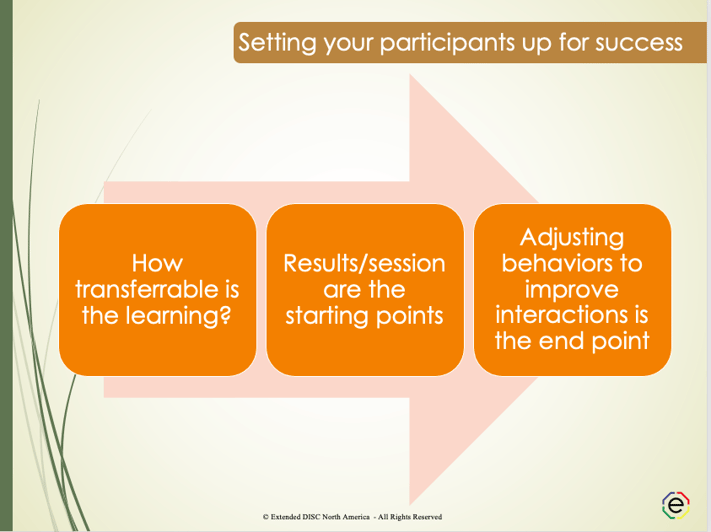 A comprehensive DISC training puts the DISC session squarely at the starting point. The end point of a successful training is the transfer of learning into the job role and life.
A comprehensive DISC training puts the DISC session squarely at the starting point. The end point of a successful training is the transfer of learning into the job role and life.
You're off to a great start because DISC itself, is a reinforcement tool. Its strength is that it's easy to learn and put into practice. It reminds you to make adjustment that better your interactions. People easily see DISC's value; how it supports your ability to interact well with others.
Unfortunately, 'life' has a tendency to get in the way. You are pulled in different directions daily and your best intentions to develop yourself go astray and opportunities are missed.
Tips for bridging learning and application

Reinforcement of learning works best when it transitions easily into your client's real life. Different and flexible post-session options enable your learners to access multiple paths to success.
Training success is determined by how well the transfer of learning is to the participant's real world. Practical and familiar post-session reinforcement is more likely to motivate participants to practice self-awareness and behavioral adjustments.
Here are some ways to provide a more comprehensive, flexible, and meaningful training. Try what works best for you and your learners.
Things to consider when building comprehensive learning
- Clearly state purpose of DISC training; what is valuable and rewarding if your participants practice DISC?
- Know your unique learners. What tends to motivate them to learn and engage in the session?
- Keep learning simple and actionable. Use relatable, realistic examples so participants can easily incorporate and transfer to their jobs.
- What support will you provide post-training? Do you need a follow-up session?
- Have clear post-session goals. What learning and activities will support personal accountability?
You're closing out a great session and you've built the bridge connecting the learning to their real world. Before the session ends is the time to start the post-session reinforcement!
Know your clients when following-up
 If you have the opportunity to follow-up one-on-one or in smaller groups, consider their DISC styles. What would be more motivating for them to continue practicing what they learned?
If you have the opportunity to follow-up one-on-one or in smaller groups, consider their DISC styles. What would be more motivating for them to continue practicing what they learned?
Follow-up emails are practical, but can be more effective if you adjust your emails to your client's style. For example, if your client is an I-style, then could your email get a better response if you picked up the phone for a quick chat first? Would your D-style better engage if the email was brief, action-oriented and clearly states their potential benefits. Get the idea?
Start reinforcement before participants leave DISC training
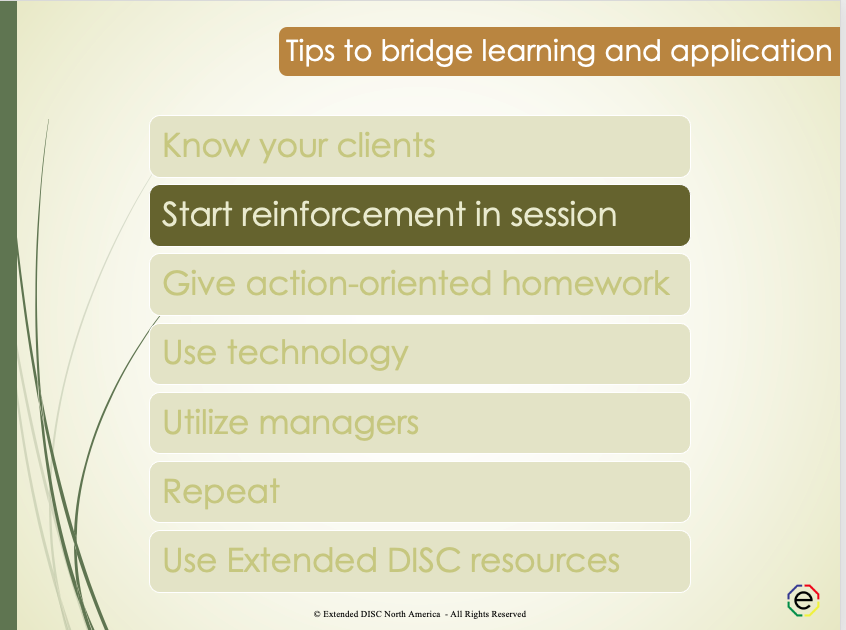 Starting their homework in session increases the likelihood of continuing it; especially when the effort generates success in practice. Different ideas include journaling their first day's learning and successes, setting a reminder check-in on their phone, or matching up learners for a 'phone a friend daily check-in'. The important thing is to commit to something before they leave your session.
Starting their homework in session increases the likelihood of continuing it; especially when the effort generates success in practice. Different ideas include journaling their first day's learning and successes, setting a reminder check-in on their phone, or matching up learners for a 'phone a friend daily check-in'. The important thing is to commit to something before they leave your session.
We know that creating a simple and concise behavioral action plan is a highly effective way to improve performance. Even if learners don't refer back to their plans, they are more consciously aware of adjustments they considered making.
The My Personal Action Plan in the back of their Individual Assessments; it couldn't be easier! It is a quick way to identify adjustments using a 'start, stop, and continue' approach. First, write down behaviors you could 'start' doing because they can help you to be more effective. Next, write down the behaviors that you should 'stop' doing because they impede your success. Finally, write down what behaviors have worked well for you and you should 'continue' doing them.
Give action-oriented homework
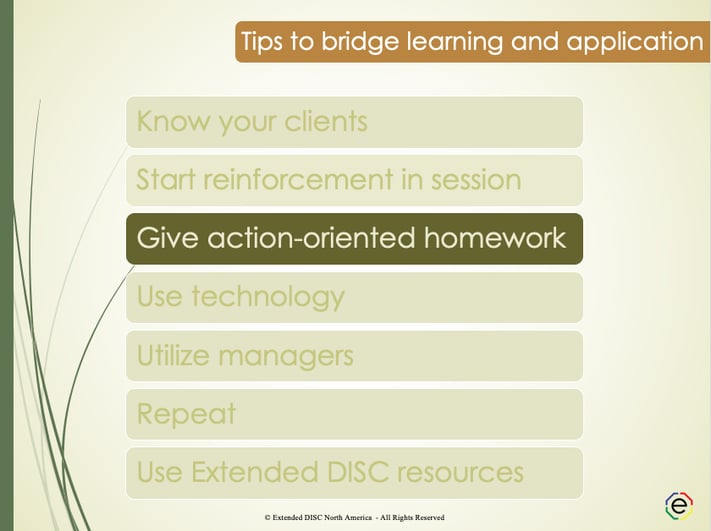
Consider the type of homework would continue the learning and application process and maintain accountability. Keep homework practical and easy to submit. Use examples that relate to their job roles.
I-styles and S-styles may prefer a phone a friend check-in. Your D-styles may want a checklist that publicly displays their accomplishments or giving themselves a score for an effective interaction. C-styles may prefer a daily self-check.
Also, keep in mind the present environment may include remote work, pandemic, etc. Would it be better to assign homework in smaller doses over an extended period of time?
Examples of homework:
-
- The Communication Strategy Worksheet is an action plan targeting someone the participant wants to improve interactions with. It is available for download from the VIP Client Resource Site.
- Check-in by reviewing 2 key adjustments learners identified in the session. Ask them questions, 'did they practice it?' 'how did it work?' and 'do you have any re-adjustments to make?'
- Keep a journal of the adjustments they did well and adding and editing their behavioral action plan.
- Use a daily check-in; whether it's a self-check or checking on someone else. They can rate themselves from 1 - 10 based on how effective their interactions were, based on how well they adjusted.
Use technology
 Your social learners may respond well to a chat group. Others may find it fun to do an online quiz; prizes can make it more motivating!
Your social learners may respond well to a chat group. Others may find it fun to do an online quiz; prizes can make it more motivating!
Learners can set up reminders and alerts in their phones or laptops with a daily affirmation. They could ask themselves what they did well today or what they will try adjusting next time. The affirmation can be as simple as 'take a breath'; the breath is the action of a pause and reminds you to reset and adjust between interactions.
Involve managers
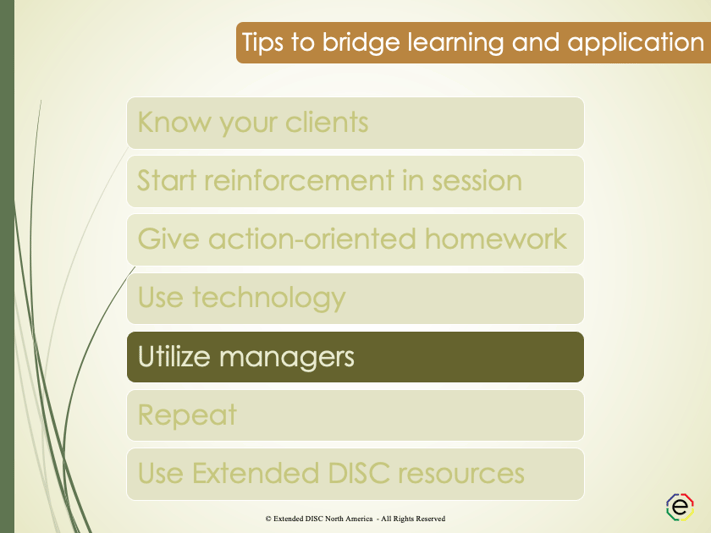 People recognize the value of DISC even more when their managers and leadership do. Managers can reinforce it daily by using the language of DISC. It may be as simple as asking their employees, 'what was the DISC style of their client?' or 'what adjustments did you consciously make with your client? They can review DISC styles in a team meeting or build DISC style identification into their CRM.
People recognize the value of DISC even more when their managers and leadership do. Managers can reinforce it daily by using the language of DISC. It may be as simple as asking their employees, 'what was the DISC style of their client?' or 'what adjustments did you consciously make with your client? They can review DISC styles in a team meeting or build DISC style identification into their CRM.
You can provide reinforcement activities for managers to use. Even if the manager simply models DISC awareness and practices conscious adjustments, they are already effective.
Repeat, revisit and reflect
 Have learners redo or revisit worksheets, DISC report, and journals to reflect and make additional observations and adjustments. Repetition and practice lead to successful habits.
Have learners redo or revisit worksheets, DISC report, and journals to reflect and make additional observations and adjustments. Repetition and practice lead to successful habits.
If you have the opportunity, follow up on their practicing of application. For example, ask them to describe a situation where they adjusted effective or what they would try next time. Discuss any additional key adjustments.
Use customized reinforcement workbooks and resources
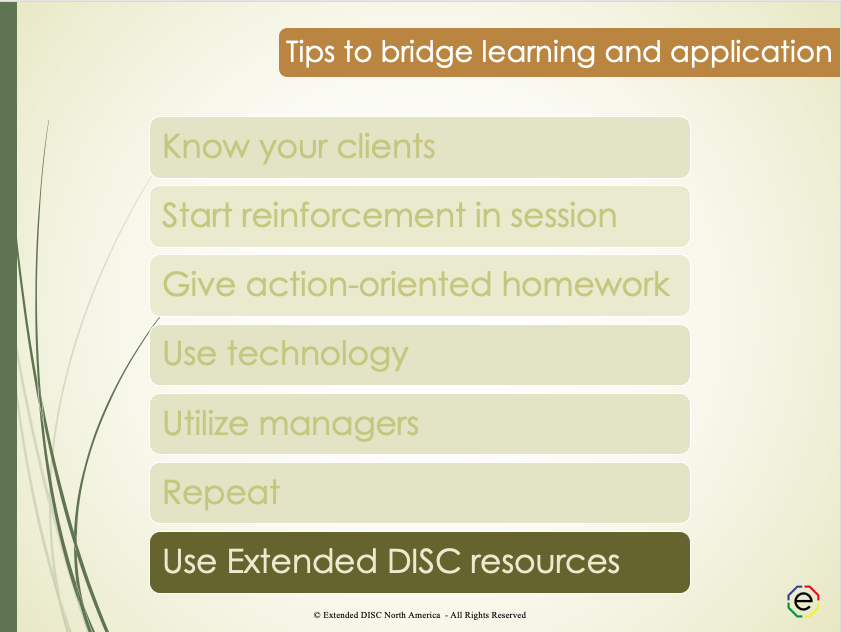
Extended DISC has a variety of resources including handouts, guides, activities, and Reinforcement Workbooks. The Client Resource Site is available to all active users of Extended DISC® Assessments.
The Reinforcement Reports are personalized, brief, standalone workbooks. Reports are topic specific and include handling stress, time management, and maximizing strengths. They are based on the learner's existing DISC Profile results so the report format and information are familiar. Key development questions are built into the reports to support practice and further development. You have the flexibility of using one, a few, or all.
Ready?
Doing all the above tips does not equal reinforcement success. Choose the ones that works for you and your learners.
Awareness and personal responsibility are key to long term success. Learners need impactful information about themselves, knowing others better, and how to adjust effectively. Help them find ways to practice DISC and build it into their everyday interactions and situations. The good news is the successes reinforce the practice; until they become a habit.

